The Political Center Is Dead, At Least On Capitol Hill
It's no wonder there's no compromise in Congress.
There’s been much commentary over the past three years or more about the extent to which American politics has become more polarized and how the Republican Party in particular has become far more ideologically conservative than it ever really was in the past, even in the days of conservative uber-hero Ronald Reagan. The effects of the polaraization are so apparent at this point that they don’t really need to be stated, but the recent shutdown is both the most recent and the worst example of a phenomenon that has become all too common on Capitol Hill. Unfortunately, it appears that it’s something that’s unlikely to disappear anytime soon.
In a new post at The Fix entitled “The death of the political center,” Chris Cillizza explains why, and it starts with this chart that notes the makeup of the House going back 31 years:
Cillizza:
In 1982, there were 344 Members whose voting records fell somewhere between the most conservative voting Democrat and the most liberal voting Republican in the House. Thirty years later, there were 11. That means that in 1982 the centrists — or at least those who by voting record were somewhere near the middle of their respective parties — comprised 79 percent of the House. In 2012 they made up 2.5 percent of the House. So, yeah.
(…)
The slide above also explains why there will be no grand or even big bargain on debt and spending — or much of anything else — anytime soon. The political incentive to make deals simply does not exist in the House and, in fact, there is almost always a disincentive for members to work across the aisle. (This is less true in the Senate where a centrist coalition — Susan Collins, Lisa Murkowski, Kelly Ayotte, Joe Manchin, Mark Pryor, Mark Begich etc — exists although that coalition has shrunk in recent years too.)
The deal-makers — as we have seen from the last month in the House — are largely gone. The two people who do seem capable of crafting deals — Vice President Joe Biden and Senate Minority Leader Mitch McConnell — come from a different time in politics.
There isn’t anything particularly new about this observation, actually. Last December, Nate Silver took of the dwindling number of swing districts in the House and at that time, I made this comment:
As Silver notes, though, the main problem that this high number of non-competitive districts creates is the fact that the Members in those districts have very different incentives from the ones that you might expect a politician to have. Instead of worrying about losing to a member of the opposing party in a General Election, their primary concern ends up being avoiding a primary challenge from the left or the right if they happen to stray from the party line. That’s why calls for compromise fall so often on deaf ears. There is more political risk for these Members of Congress in compromising than there is in holding the line. As long as that’s the case, then things are not likely to change on Capitol Hill.
This is an observation that has pretty much become an axiom at this point, of course, but it doesn’t entirely explain what we see in the chart above. It shows that just as much as the GOP Caucus has moved to the the right, the Democratic Caucus has moved to the left. Much of this can be attributed to the decimation of what came to be known in as the Blue Dog Democrats, meaning Democrats who represented districts that leaned Republican or which had a more conservative political leaning generally even if they tended to elect Democrats. At one time, the “Blue Dog” Caucus was quite a considerable force that tended to temper some of the more left wing members of the Democratic caucus. However, many of those members saw their careers cut short thanks to the 2010 elections when their constituents decided to elect a conservative Republican instead of a mostly conservative Democrat who would still be part of a caucus that tilted to the left. As a result, the “Blue Dog” Caucus today is down to a handful of members at best and has almost no influence inside the House Democratic Caucus.
The same is true of whatever name you want to give to old style “moderate” Republicans. Thirty years ago, the House GOP Caucus was headed by Bob Michael, a moderate Republican out of Illinois and the House Caucus included people as conservative as Phil Crane, also a Congressman from Illinois. The Democratic caucus included anti Vietnam War activists along with Scoop Jackson Democrats. Today, I’m not sure you can find nearly as much ideological diversity inside the individual caucuses, and it means that there is far less room for agreement when it comes to the truly contentious issues of the day.
Back in the 1980s, President Reagan was able to hammer out things like the 1981 tax cut, the agreement to reform Social Security, and the landmark deals in 1986 on both tax reform and immigration reform both because he was able to work with Democrats like Tip O’Neill and because Democrats and Republicans on Capitol Hill were able to work together to get important legislation done. When was the last time we saw that happen? Perhaps my memory is failing me, but it seems to me as though that every major piece of legislation passed in the last several years, even going back before Barack Obama was President, was passed along highly partisan lines. Indeed, even the laws authorizing Social Security and Medicare passed with relatively respectable bipartisan majorities. Even if you think those were both bad laws, you have to recognize the difference between a law passed by the brute force of one party majority rule and one passed with a bipartisan majority.
Whatever the reasons might be, it seems clear that we’ve got two sides of a political argument that are pretty much just yelling at each other at this point rather than talking to each other. And that is completely unhealthy.

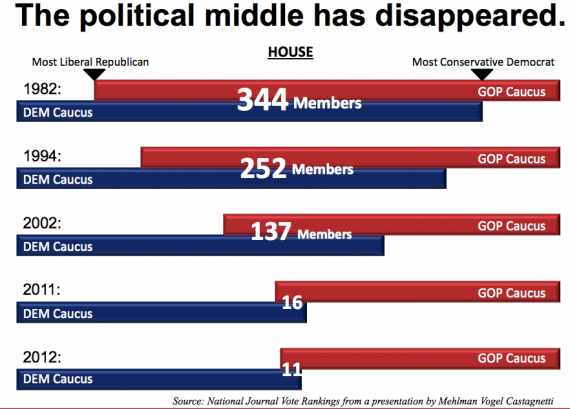


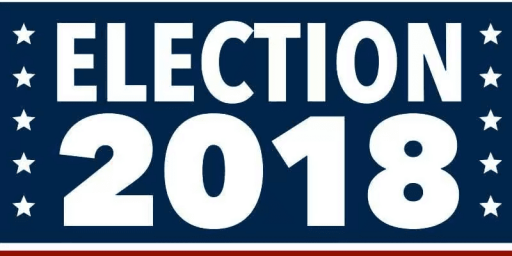
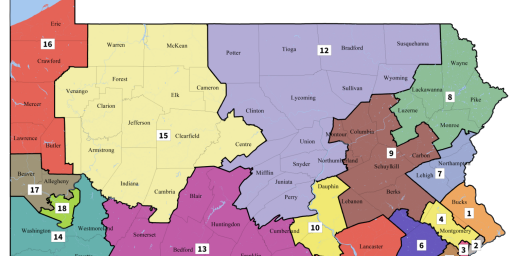
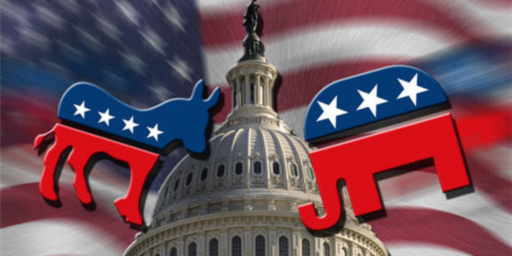
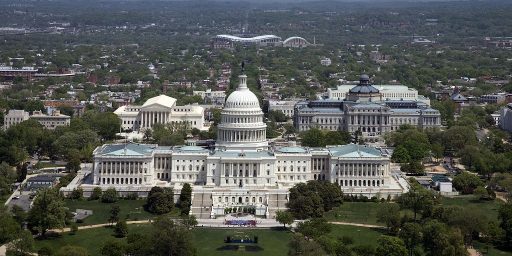
If the center is the middle rhan your right, but i don’t know of anyone in congress that is fighting for a solid left position.
Completely unhealthy, yes.
BOTH sides yelling past each other, not so much.
The recent deal that ended the government shutdown had the entire House Democratic caucus voting for what was very much not a “liberal” bill.
One party acts like spoiled toddlers throwing hissy fits if they don’t get exactly what they want. That is the primary reason that nothing gets done in Washington.
I’m sorry, but “both sides” don’t “do it”.
…When the leadership of one political party gets together before the inaguration of a new president of the opposite party and decides they will block all legislation coming from the new administration regardless of whether it is a republican or democratic idea … then yeah, the wiggle room in the middle dissapears.
…The house has 200 members who would pass many pieces of legislation if leadership would allow votes. It doesn’t due to a “Hastert Rule” which is no rule at all.
Both sides do it again….this is getting boring Doug.
The Blue on the chart should move only slightly rightward (Obama and Clinton are essentially centrists, and largely of the same political stripe), and the red should be moving further and further rightward. So yes, because the political “middle” has moved right I suppose the overlap has shrunk – but you are mistaken as to the cause.
Exactly, the Democrats did not move to the left, they were just much slower to follow the Republicans to the right.
One would think that if the Republicans kicked out conservative leaning dems and centrist Repubs that the left didn’t move at all. The Republicans went way right while concurrently destroying the center in both parties. But I guess both sides do it.
Thats an incredibly charitable way of putting it. This is Jenos/Bithead/Super country.
I posted a link a week or two about the population, showing a good sized moderate center, but yes those moderates are not well represented.
I will offer an easy way to test how a party contributes to their own extremism though.
Look at how many moderates they throw out.
Democrats? Can anyone think of anyone “primaried” for being too moderate?
The overlap from the parties is separate from the radicalization of the GOP. It’s quite true there is much less overlap, and both sides are much more uniform. It’s not true they’ve both become equally radical.
These days the Democratic Party is not extreme while the Republican Party is. This is not an equal proposition. One side is disproportionately extreme, and it’s not the Democratic Party.
Both sides do it…………again.
Zzzzzzzzzzzzzzzzzzzzzzzzzz
There’s not going to be a bargain because Obama has made three offers and Boehner couldn’t deliver his caucus for any of the three.
But really…both sides do it.
Jesus-god.
john personna: Arlen Specter and Joe Lieberman.
Granted it doesn’t happen with the regularity of GOP primaries — there are no PACs dedicated to that cause on the left — but it does happen.
@Peacewood:
I’m not sure Specter really qualifies given his recent switch from the GOP and can you say for sure that Lieberman was primaried for being too moderate? You shouldn’t discount what a giant tool he was or his Iraq warmongering.
@Peacewood:
Add Blanche Lincoln to that list. There’s a good chance even a Democrat as relatively conservative as Lincoln wasn’t going to win in Arkansas in 2010, but it certainly couldn’t have helped that she had to spend the spring responding to a challenge from her left.
@Todd:
Yes, Lincoln is a much better example.
@this:
Dear idiot downvoter, I was actually giving you a chance.
If you think the Democrats have moved left in the same way as the Republicans have moved right, tell us who they’ve thrown out, as too moderate (as the Republicans to time and again with their RINOs).
@john personna:
I’m not the down voter, but just to clarify my point about Lincoln … I don’t think she was primaried for being “too moderate”. She got a primary challenge because along with Ben Nelson, and Max Baucus she’s largely responsible for the fact that the PPACA doesn’t include a public option. The left had good reason to be mad at her … doesn’t mean the primary was necessarily a “good” idea … but somewhat understandable.
Oddly, examining that specific example makes me feel somewhat more sympathetic to the rational for Conservative primary challenges to Republicans who don’t “toe the line”.
@Peacewood:
I don’t think those guys quite make the test. I mean, look at how Specter wandered himself:
@Todd:
I’ve never heard of Blanche Lincoln, and maybe that is one.
(I think Lieberman also was a “wanderer.”)
I just posted something of interest to this thread (I think): click.
@Todd:
That’s where the radicalization of the GOP comes in, as any compromise is now grounds for a primary. Heck, just deciding that maybe the country shouldn’t voluntarily default and the government should reopen means they may face a primary now. This isn’t the case where they are going to primary Republicans that support Obamacare or are compromising on Climate Change legislation. They are facing primaries for being willing to do their jobs and legislate constructively.
@David M:
Don’t get me wrong, I’m not saying that Conservatives are not radical. I think the primary challenges are bad for our system of government (we really need open, or even better jungle style non-partisan primaries). But from the perspective of the wild-eyed Conservative who believes everything they read on WND, I do understand why they want a primary challenger to even Congressmen or Senators that most normal people would consider relatively right-wing.
I guess my point in this case is that I think the Left was (irrationally) emulating the Right when they mounted a primary against Lincoln. The decision was driven by anger rather than probability of success.
It seems somewhat ironic to me that the people in the “progressive” party say that the other side is “moving away” from the middle while they (progressives) are standing still.
How are we defining conservative, liberal, and radical in this conversation? Reading through the comments it isn’t clear they are being used consistently.*
Southern Democrats up to and through the late 50s and early 60s and into the present are shown to be more liberal than Northeastern Republicans. I’m trying to wrap my head around a consistent definition of any of these terms that allows that to be true. Are social issues ignored in favor of economic?
* This is a general problem in political commentary.
Does it? If the GOP moved a lot to the right and the Dems stayed where they were wouldn’t the graph be the same?
Or to put it another way, if in 2011 and 2012 Republicans were voting against every bill brought forward by Democrats, even if it was something they previously favored, wouldn’t that show these results?
@Blue Shark:
But all of those bills would massively benefit the Democrats in the long run. There are 20 or so Republicans who seem content to be in office in order to receive a few scraps of the Democratic Party until the changing demographics of the U.S. eliminate conserative politics.
People always forget that there is no reason for the Democrats to compromise in the long run because the Democrats know that every demographic change in the U.S. is in their favor. The Democrats have rather go years under continuing resolution while waiting to retake the House instead of compromise.
@Tony W:
It is hard to believe that the U.S. has moved to the right while I am taking my shoes off at the airport. It is hard to believe the U.S. has moved to the right when I fill out by income tax returns. While trying to comply with new federal security and decontamination rules for hazardous materials that are designed to convinced users to get out of the business, it is hard to believe that the U.S. has moved to the right.
Maybe one of the problems for the Republicans is how few victories the Republicans have actually managed to deliver for conservatives but how many victories they have delivered for Democrats.
@superdestroyer:
Are you seriously blaming the Democratic party for the explosion of vomit that is Patriot Act and the TSA?
Have you noticed, when filling out those tax returns, that the uber-rich pay way lower taxes than you? Did you notice the repeal of Glass-Stegal? The end of welfare-as-we-know-it? How about the Supreme Court’s recent gutting of the Civil Rights Act, or Citizens United? Medicare Part D’s giveaway to the drug companies?
Even Obama’s signature achievement – the ACA – is essentially a conservative plot creating a forced consumer market for a private product.
Spare me the victim mentality of your poor, oppressed white Christian minority.
@superdestroyer:
“It is hard to believe the U.S. has moved to the right when I fill out by income tax returns.”
Are you seriously suggesting that if you had the same income (adjusted for inflation) in 1950 as you do now, you would not need to fill out an income tax return?
Giving that chart a quick look, it seems to me a great example of failing to show the really important information.
Based on the look of the chart it appears that each party is moving away from each other equally, towards fixed ideological points. Given other data out there, this seems not to be the case. Based on other surveys, it’s pretty clear that the right has become *more conservative* at a greater rate than the left has shifted towards being *more liberal.*
Beyond that, this chart also makes it appear that there is a smooth/equal distribution in each party between the most *liberal* and *conservative* members. This is unlikely to be the case. It would be much more helpful to see a scatter plot along the line to see where the majority of members are clustered. That would, hopefully give us a better idea of the severity of the situation.
@superdestroyer:
The Patriot Act and the TSA certainly as hell did not originate from the left.
Taxes are historically low. Under Eisenhauer, the top marginal rate was 92%. You think the Left likes the current tax rates?
@superdestroyer: “It is hard to believe that the U.S. has moved to the right while I am taking my shoes off at the airport. ”
Hey, after reading your screeds for years, I think I finally understand what you’re talking about.
When you say “liberal,” what you mean is “anything I don’t like.”
Because that’s the only conceivable way to call the TSA security theater “liberal.” And once we understand this, everything else you say actually kind of makes sense. At least in the sense of “I’m mad because the world I fantasize as existing is going away.”
@mattbernius: Exactly. The graph could be a counter-example of a technically correct but substantively flawed and misleading analysis in the great books on conveying information graphically.
@wr & @Ben: : You guys said it with more class, but “explosion of vomit” has its fans too….maybe that’s the name for my new band.
Elsewhere on this blog, Stephen Taylor and the ensuing discussion essentially eviscerate this incredibly misleading chart. Doug, not surprisingly, takes the evidence offered as proof that Progressives just don’t give him enough respect.
Whenever religion is allowed to take over politics u get more extreme conservatism against minorities, more inequality, more abuse of power, more violence; rape; murder etc. Just look throughout history world-wide. Sure there are many good-hearted religious folks who believe they’re way is the only way to make a moral utopia, but once conservatives take charge, it becomes “us against them”. It used to be just election years we’d see the conservatives being out the three G’s; Guns, God, and Gays… but you can see the 24/7 blatant three G mentality, it shows its ugly head whenever the non-conformist aka less Conservative party is given more powers, hence the reason why the Repubs always shut down the gov when a Democrat has been in the WH over the last century, maybe even longer… it’s hard to always make a point when at one time the Democratic Party was the racist party….and here is a great example: the Republicans wanted more power and they used what’s called the Southern Stratergy, which ironically still lingers today, to get the “Us vs Them” ball rolling, and they certainly came out all guns a blazing with the black man in the WH. Sadly, they know just how stupid conservative minded people are, so they bait them and win them. That is how all dictators get into powers, Hitler most famously, but not the most successful over the centuries, but he is a perfect example of a Conservative Christian. Great legacy to have there conservatives!